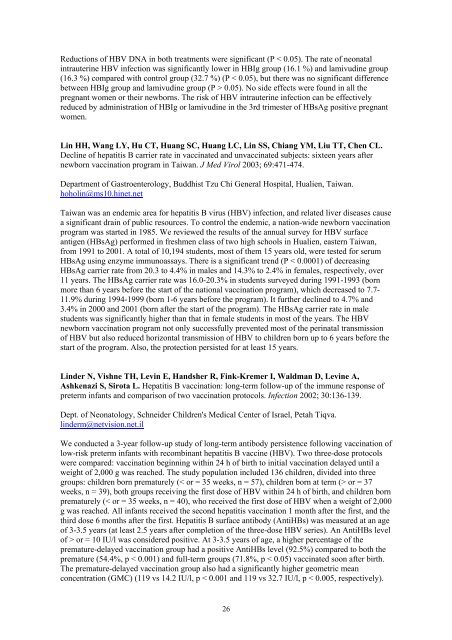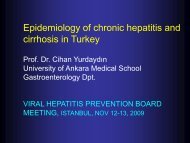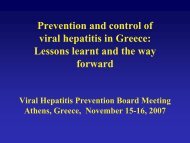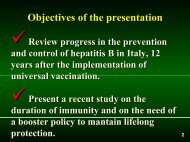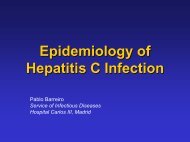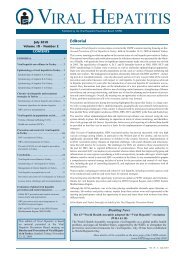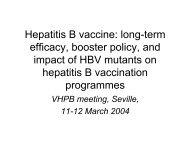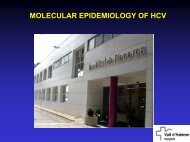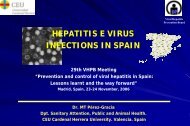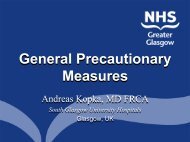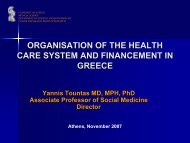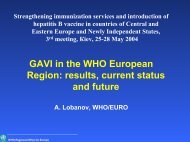Reductions <strong>of</strong> HBV DNA <strong>in</strong> both treatments were significant (P < 0.05). The rate <strong>of</strong> neonatal<strong>in</strong>trauter<strong>in</strong>e HBV <strong>in</strong>fection was significantly lower <strong>in</strong> HBIg group (16.1 %) <strong>and</strong> lamivud<strong>in</strong>e group(16.3 %) compared with <strong>control</strong> group (32.7 %) (P < 0.05), but there was no significant differencebetween HBIg group <strong>and</strong> lamivud<strong>in</strong>e group (P > 0.05). No side effects were found <strong>in</strong> all thepregnant women or their newborns. The risk <strong>of</strong> HBV <strong>in</strong>trauter<strong>in</strong>e <strong>in</strong>fection can be effectivelyreduced by adm<strong>in</strong>istration <strong>of</strong> HBIg or lamivud<strong>in</strong>e <strong>in</strong> the 3rd trimester <strong>of</strong> HBsAg positive pregnantwomen.L<strong>in</strong> HH, Wang LY, Hu CT, Huang SC, Huang LC, L<strong>in</strong> SS, Chiang YM, Liu TT, Chen CL.Decl<strong>in</strong>e <strong>of</strong> <strong>hepatitis</strong> B carrier rate <strong>in</strong> vacc<strong>in</strong>ated <strong>and</strong> unvacc<strong>in</strong>ated subjects: sixteen years afternewborn vacc<strong>in</strong>ation program <strong>in</strong> Taiwan. J Med Virol 2003; 69:471-474.Department <strong>of</strong> Gastroenterology, Buddhist Tzu Chi General Hospital, Hualien, Taiwan.hohol<strong>in</strong>@ms10.h<strong>in</strong>et.netTaiwan was an endemic area for <strong>hepatitis</strong> B <strong>virus</strong> (HBV) <strong>in</strong>fection, <strong>and</strong> related liver diseases causea significant dra<strong>in</strong> <strong>of</strong> public resources. To <strong>control</strong> the endemic, a nation-wide newborn vacc<strong>in</strong>ationprogram was started <strong>in</strong> 1985. We reviewed the results <strong>of</strong> the annual survey for HBV surfaceantigen (HBsAg) performed <strong>in</strong> freshmen class <strong>of</strong> two high schools <strong>in</strong> Hualien, eastern Taiwan,from 1991 to 2001. A total <strong>of</strong> 10,194 students, most <strong>of</strong> them 15 years old, were tested for serumHBsAg us<strong>in</strong>g enzyme immunoassays. There is a significant trend (P < 0.0001) <strong>of</strong> decreas<strong>in</strong>gHBsAg carrier rate from 20.3 to 4.4% <strong>in</strong> males <strong>and</strong> 14.3% to 2.4% <strong>in</strong> females, respectively, over11 years. The HBsAg carrier rate was 16.0-20.3% <strong>in</strong> students surveyed dur<strong>in</strong>g 1991-1993 (bornmore than 6 years before the start <strong>of</strong> the national vacc<strong>in</strong>ation program), which decreased to 7.7-11.9% dur<strong>in</strong>g 1994-1999 (born 1-6 years before the program). It further decl<strong>in</strong>ed to 4.7% <strong>and</strong>3.4% <strong>in</strong> 2000 <strong>and</strong> 2001 (born after the start <strong>of</strong> the program). The HBsAg carrier rate <strong>in</strong> malestudents was significantly higher than that <strong>in</strong> female students <strong>in</strong> most <strong>of</strong> the years. The HBVnewborn vacc<strong>in</strong>ation program not only successfully prevented most <strong>of</strong> the <strong>per<strong>in</strong>atal</strong> <strong>transmission</strong><strong>of</strong> HBV but also reduced horizontal <strong>transmission</strong> <strong>of</strong> HBV to children born up to 6 years before thestart <strong>of</strong> the program. Also, the protection persisted for at least 15 years.L<strong>in</strong>der N, Vishne TH, Lev<strong>in</strong> E, H<strong>and</strong>sher R, F<strong>in</strong>k-Kremer I, Waldman D, Lev<strong>in</strong>e A,Ashkenazi S, Sirota L. Hepatitis B vacc<strong>in</strong>ation: long-term follow-up <strong>of</strong> the immune response <strong>of</strong>preterm <strong>in</strong>fants <strong>and</strong> comparison <strong>of</strong> two vacc<strong>in</strong>ation protocols. Infection 2002; 30:136-139.Dept. <strong>of</strong> Neonatology, Schneider Children's Medical Center <strong>of</strong> Israel, Petah Tiqva.l<strong>in</strong>derm@netvision.net.ilWe conducted a 3-year follow-up study <strong>of</strong> long-term antibody persistence follow<strong>in</strong>g vacc<strong>in</strong>ation <strong>of</strong>low-risk preterm <strong>in</strong>fants with recomb<strong>in</strong>ant <strong>hepatitis</strong> B vacc<strong>in</strong>e (HBV). Two three-dose protocolswere compared: vacc<strong>in</strong>ation beg<strong>in</strong>n<strong>in</strong>g with<strong>in</strong> 24 h <strong>of</strong> birth to <strong>in</strong>itial vacc<strong>in</strong>ation delayed until aweight <strong>of</strong> 2,000 g was reached. The study population <strong>in</strong>cluded 136 children, divided <strong>in</strong>to threegroups: children born prematurely (< or = 35 weeks, n = 57), children born at term (> or = 37weeks, n = 39), both groups receiv<strong>in</strong>g the first dose <strong>of</strong> HBV with<strong>in</strong> 24 h <strong>of</strong> birth, <strong>and</strong> children bornprematurely (< or = 35 weeks, n = 40), who received the first dose <strong>of</strong> HBV when a weight <strong>of</strong> 2,000g was reached. All <strong>in</strong>fants received the second <strong>hepatitis</strong> vacc<strong>in</strong>ation 1 month after the first, <strong>and</strong> thethird dose 6 months after the first. Hepatitis B surface antibody (AntiHBs) was measured at an age<strong>of</strong> 3-3.5 years (at least 2.5 years after completion <strong>of</strong> the three-dose HBV series). An AntiHBs level<strong>of</strong> > or = 10 IU/l was considered positive. At 3-3.5 years <strong>of</strong> age, a higher percentage <strong>of</strong> thepremature-delayed vacc<strong>in</strong>ation group had a positive AntiHBs level (92.5%) compared to both thepremature (54.4%, p < 0.001) <strong>and</strong> full-term groups (71.8%, p < 0.05) vacc<strong>in</strong>ated soon after birth.The premature-delayed vacc<strong>in</strong>ation group also had a significantly higher geometric meanconcentration (GMC) (119 vs 14.2 IU/l, p < 0.001 <strong>and</strong> 119 vs 32.7 IU/l, p < 0.005, respectively).26
Delay<strong>in</strong>g vacc<strong>in</strong>ation <strong>of</strong> premature <strong>in</strong>fants aga<strong>in</strong>st <strong>hepatitis</strong> B until a weight <strong>of</strong> 2,000 g wasreached resulted <strong>in</strong> both a significantly higher percentage <strong>of</strong> children with positive antibody levels<strong>and</strong> a significantly higher GMC at 3-3.5 years <strong>of</strong> age as compared to early-vacc<strong>in</strong>ated preterm <strong>and</strong>full-term <strong>in</strong>fants. The known short-term advantage <strong>of</strong> delayed vacc<strong>in</strong>ation <strong>of</strong> preterm <strong>in</strong>fants wasshown to persist for at least the first 3 years <strong>of</strong> life.Liu Y, Liu X, Kuang J. Compar<strong>in</strong>g immunogenicity <strong>and</strong> efficacy <strong>of</strong> two <strong>hepatitis</strong> B vacc<strong>in</strong>es <strong>in</strong>newborn <strong>in</strong>fants <strong>of</strong> <strong>hepatitis</strong> B surface antigen (+)/<strong>hepatitis</strong> B e antigen (+) carrier mothers.Zhonghua Fu Chan Ke Za Zhi 1999; 34:470-472. [Article <strong>in</strong> Ch<strong>in</strong>ese]Department <strong>of</strong> Obstetrics <strong>and</strong> Gynecology, Sun Sat-Sen Memorial Hospital, Guangzhou 510120,Ch<strong>in</strong>a.The objective was to <strong>in</strong>vestigate a practical diagnostic method <strong>in</strong> cl<strong>in</strong>ic for fetuses <strong>in</strong>fect<strong>in</strong>g with<strong>hepatitis</strong> B (HBV) <strong>and</strong> study the mutual effects between fetal <strong>in</strong>fection <strong>and</strong> cl<strong>in</strong>ical factors. Venousblood was drawn from 144 cases <strong>of</strong> HBV carrier mothers <strong>and</strong> their neonates. HBV DNA wasdetected by polymerase cha<strong>in</strong> reaction (PCR) <strong>and</strong> hybridization, HBV M was detected by enzymel<strong>in</strong>ked immunoadsorbent assay (ELISA), <strong>and</strong> aspartate am<strong>in</strong>otransferase/alan<strong>in</strong>e am<strong>in</strong>otransferase(AST/ALT) was detected by IFCC. Umbilical blood <strong>and</strong> femoral blood was taken from 40 <strong>of</strong> 144neonates for HBV DNA detection. Cl<strong>in</strong>ical data, neonatal AST <strong>and</strong> ALT level were comparedbetween fetal <strong>in</strong>fection group <strong>and</strong> <strong>control</strong> group. Results: (1) The fetal <strong>in</strong>fectious rate was 22.9%(33/144). Compar<strong>in</strong>g with peripheral venous blood sample, the sensitivity <strong>and</strong> positive predictivevalue <strong>of</strong> HBV DNA detected <strong>in</strong> cords was 100.0%, 80.0% respectively. Follow<strong>in</strong>g up the <strong>in</strong>fants,HBV DNA was found persistently positive <strong>in</strong> 7 <strong>of</strong> 28 <strong>in</strong>trauter<strong>in</strong>e <strong>in</strong>fectious <strong>in</strong>fants 6approximately 9 months after birth. HBsAg was found chang<strong>in</strong>g to be negative 1 month later <strong>in</strong> the<strong>in</strong>fants with HBsAg positive at birth. (2) The fetal <strong>in</strong>fectious rate <strong>in</strong> mothers with HBeAg (+) orHBV DNA (+) was 70.5%, 61.1% respectively which was significantly higher than that <strong>in</strong> motherswith HBeAg (-) or HBV DNA (-). P < 0.01. There was no significantly difference <strong>in</strong> mothers' age,gestational age, delivery way, birth weight (BW), body length (BL), Apgar score between fetal<strong>in</strong>fectious group <strong>and</strong> <strong>control</strong> group. (3) The mean value <strong>of</strong> AST, ALT <strong>in</strong> fetal <strong>in</strong>fectious group was(61.2 +/- 31.3) IU, (24.7 +/- 14.9) IU respectively, which was significantly higher than that <strong>in</strong><strong>control</strong> group [(55.2 +/- 37.1) IU, (19.0 +/- 10.1) IU]. P < 0.01. Conclusions: (1) Detection <strong>of</strong>HBV DNA <strong>in</strong> cord blood is a sensitive <strong>in</strong>dex for diagnos<strong>in</strong>g fetal <strong>in</strong>fection, however detection <strong>of</strong>peripheral venous blood is with the significance <strong>of</strong> mak<strong>in</strong>g correct diagnosis. (2) HBsAg or HBVDNA positive <strong>in</strong> mothers is one <strong>of</strong> the risk factors <strong>of</strong> <strong>in</strong>trauter<strong>in</strong>e <strong>in</strong>fection. There is no relationshipamong fetal <strong>in</strong>fection <strong>and</strong> mothers' age, gestational age, delivery way, neonates' sex, BW, BL. (3)The liver function <strong>of</strong> neonates <strong>in</strong>fected with HBV <strong>in</strong>trauter<strong>in</strong>ely maybe impaired to some extent.Liu ZH, Men K, Xu D. A follow-up study on correlated factors for <strong>in</strong>trauter<strong>in</strong>e <strong>in</strong>fection <strong>of</strong><strong>hepatitis</strong> B <strong>virus</strong>. Zhonghua Yu Fang Yi Xue Za Zhi 1997; 31:263-265. [Article <strong>in</strong> Ch<strong>in</strong>ese]Department <strong>of</strong> Epidemiology, Fourth Military Medical University, Xi'an.One hundred <strong>and</strong> twenty-two pregnant women with positive serum <strong>hepatitis</strong> B surface antigen(HBsAg) <strong>and</strong> their <strong>in</strong>fants were followed-up to study the risk factors related to <strong>in</strong>trauter<strong>in</strong>e<strong>in</strong>fection <strong>of</strong> <strong>hepatitis</strong> B <strong>virus</strong> (HBV). Infants were immunized with three doses <strong>of</strong> <strong>hepatitis</strong> Bvacc<strong>in</strong>e with<strong>in</strong> 24 hours after birth, one month <strong>and</strong> six months <strong>of</strong> age, respectively, <strong>and</strong> <strong>hepatitis</strong> Bimmunoglobul<strong>in</strong> (HBIg) was <strong>in</strong>jected simultaneously with the first dose. Markers <strong>of</strong> HBV<strong>in</strong>fection <strong>in</strong> pregnant women <strong>and</strong> <strong>in</strong>fants were detected by enzyme l<strong>in</strong>ked immunosorbent assay(ELISA). Results showed that 13 <strong>in</strong>fants were detected positive for HBsAg <strong>in</strong> their sera, eight <strong>of</strong>them were positive at their birth <strong>and</strong> the other five converted positive dur<strong>in</strong>g follow-up. Simple<strong>and</strong> multiple logistic regression analyses showed that positivity <strong>of</strong> <strong>hepatitis</strong> Be antigen (HBeAg) <strong>in</strong>27
- Page 1 and 2: Pre-meeting documentPrevention and
- Page 3 and 4: Part I Prevention and control of pe
- Page 5 and 6: prevalence was significantly higher
- Page 7 and 8: clusters (obstetrics wards/hospital
- Page 9 and 10: Boxall E. Screening of pregnant wom
- Page 11 and 12: Chang MH, Hsu HY, Huang LM, Lee PI,
- Page 13 and 14: of infection in infants and childre
- Page 15 and 16: Eriksen EM, Perlman JA, Miller A, M
- Page 17 and 18: liver enzyme abnormalities than wer
- Page 19 and 20: health care, is feasible and achiev
- Page 21 and 22: HBsAg and anti-HBs in 4.5%. In the
- Page 23 and 24: immunoprophylaxis. Reflecting effec
- Page 25: Levin CE, Nelson CM, Widjaya A, Mon
- Page 29 and 30: diagnosis. In the past, the inciden
- Page 31 and 32: shows that the prevalence of HBV in
- Page 33 and 34: Niu MT, Targonski PV, Stoll BJ, Alb
- Page 35 and 36: Ranger-Rogez S, Alain S, Denis F. H
- Page 37 and 38: vaccinees) and low reactogenicity o
- Page 39 and 40: single ELISA test is about Rs40. At
- Page 41 and 42: newborns with surface antigenemia,
- Page 43 and 44: Wang Z, Zhang J, Yang H, Li X, Wen
- Page 45 and 46: of hepatitis B vaccine. This study
- Page 47 and 48: transmission has been estimated at
- Page 49 and 50: at birth and 2 weeks after birth, f
- Page 51 and 52: Chubinishvili OV, Mikhailov MI, Sak
- Page 53 and 54: Jensen L, Heilmann C, Smith E, Want
- Page 55 and 56: Onishchenko GG. Incidence of infect
- Page 57: Zanetti A, Tanzi E, Semprini AE. He


